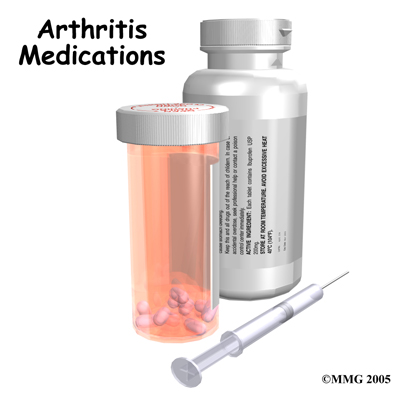Uses of DMARDs
DMARDs are primarily used to treat rheumatoid arthritis (RA) and other systemic diseases. In the past twenty years, DMARDs (which are also called slow-acting antirheumatic drugs) have become much more widely used.
The idea behind using DMARDs is to prevent joint damage. This means you start using them early on, and you switch drugs or doses when your current drugs stop working. Using DMARDs requires you to be alert for possible side effects. You also need to be patient as DMARDs take time to work, but they can be very effective at slowing the course of your disease. DMARDs, however, do not cure disease. Very few patients see their disease go into a complete remission. Most patients find that their symptoms come back after months, or sometimes years of improvement on DMARDs.
Doctors often prescribe DMARDs, corticosteroids, and NSAIDs at the same time. The DMARDs affect the underlying disease, and the corticosteroids and NSAIDs give relief from pain and inflammation. Sometimes doctors prescribe two or more DMARDs together. There are few studies to prove how well these combinations work, however, using more than one DMARD does not seem to cause problems with higher toxicity. This means that taking more than one DMARD isn't any harder on your body than taking just one.
Types and Complications of DMARDs
There are many different types of DMARDs, with different effects and complications. Some are used only for specific types of diseases.
Antimalarial Drugs
Hydroxychloroquine and chloroquine have been used since the 1950s for rheumatic diseases but they have been used against malaria for much longer. These drugs are mostly used for RA and lupus. Chloroquine has more side effects. Side effects include indigestion, rash, and eye problems. Antimalarial drugs take three to four months to show results.
Penicillamine
This drug affects the way your immune system functions. Almost 25 percent of patients who take it experience bad side effects within the first year. The most common side effects are rashes, blood and protein in the urine, low numbers of platelets in the blood, and autoimmune problems including drug-induced lupus. Taking penicillamine requires regular blood and urine tests.
Sulfasalazine
This fairly new drug is used primarily in RA and spondyloarthropathies (arthritis of the spine). It may slow down erosions of bone. Almost half of patients develop side effects in the first four months, but most of the reactions are minor. Side effects include rashes, nausea, abdominal pain, liver and blood disorders, low sperm counts, and discolored urine and sweat. You will need liver and blood tests for the first months on this drug.
Gold
Gold compounds have been used for eighty years to treat RA. They are also used in juvenile chronic arthritis and psoriatic arthritis. Gold is injected into your muscles, usually once a week. Most patients only use gold compounds for one to five years. After about a year, most patients stop seeing benefits from using gold therapy. And most patients also start having complications. Unwanted side effects include diarrhea, rashes, low levels of platelets and other blood disorders, protein in the urine, lung problems, and sores of the mucous membranes, especially in the mouth. Using gold compounds requires regular blood and urine tests.
Methotrexate
Methotrexate shows results in one to two months. Most patients stay on it longer than other DMARDs. In the short term, methotrexate causes nausea, loss of appetite, and high levels of certain liver enzymes. As with all the other DMARDs, there are serious complications with long-term use. It can cause liver damage and lung disease.
Azathioprine
This drug is most often used in RA, lupus, and other connective tissue diseases. It can also help offset the negative effects of steroids. Azathioprine is as effective as other DMARDs, but it also has more side effects. It can cause nausea, vomiting, diarrhea, bone marrow suppression, and hepatitis. The most troubling long-term side effect is cancer of the lymph system.
Nitrogen Mustard Alkylating Agents
Chlorambucil and cyclophosphamide are the main alkylating agents used as DMARDs. Chlorambucil is usually used to treat RA, juvenile chronic arthritis, vasculitis, systemic sclerosis, and ankylosing spondylitis. However, it can damage the chromosomes. This creates a higher risk for leukemia and other kinds of cancers.
Cyclophosphamide can be taken by mouth or intravenously. It is usually used to treat severe RA, lupus, and systemic vasculitis. Significant negative side effects are common. They include inflammation and bleeding of the ulcer, suppression of the immune system, reproductive problems in men and women, and cancer that may show up long after the drug is stopped.
Cyclosporine
Cyclosporine can be very effective against RA, but most people who take it develop kidney problems and high blood pressure. Kidney function goes back to normal when you stop taking the drug.
As with NSAIDs and corticosteroids, you and your doctor will need to work together to find the best type and dose of DMARDs for your disease.
Portions of this document copyright MMG, LLC.


